Warley Plumbing Solutions: Project Management and Business Case Report
VerifiedAdded on 2022/12/15
|12
|2687
|499
Report
AI Summary
This report provides a comprehensive analysis of Warley Plumbing Solutions, focusing on project management and business strategies. It begins with a business case, outlining the company's mission, vision, goals, objectives, and value statements. A strategic map is presented, detailing the firm's operational management and financial strategies. The report includes a cost-benefit analysis and risk assessments, along with alternative strategies. Task 2 delves into the Work Breakdown Structure (WBS) and Gantt chart for project planning and task management. Task 3 examines the role of a project manager, covering ethical, social, and legal considerations. Finally, Task 4 discusses Key Performance Indicators (KPIs) and quality assurance measures. The report emphasizes the importance of strategic planning, effective communication, and quality control in achieving project success within Warley Plumbing Solutions.
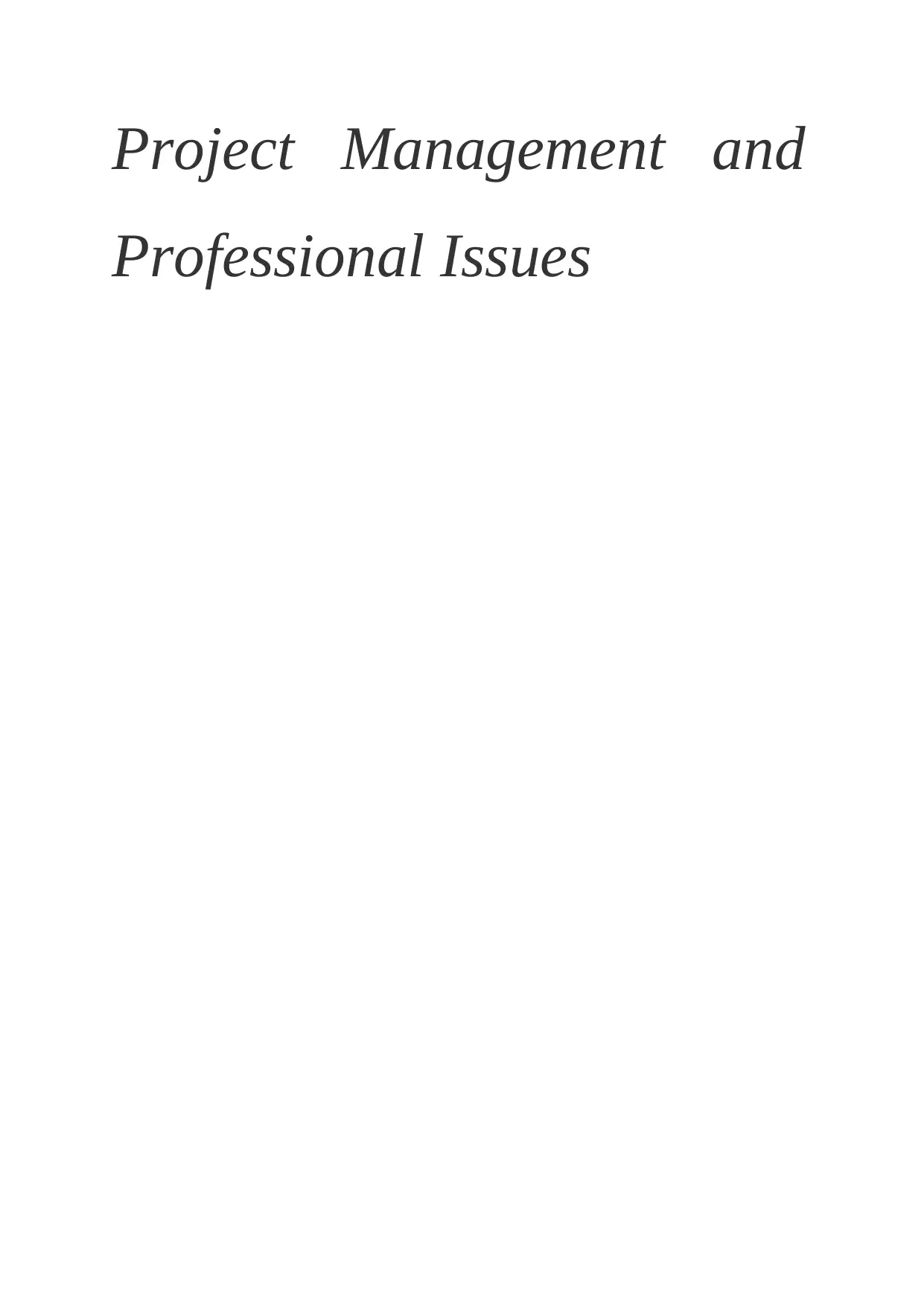
Project Management and
Professional Issues
Professional Issues
Paraphrase This Document
Need a fresh take? Get an instant paraphrase of this document with our AI Paraphraser
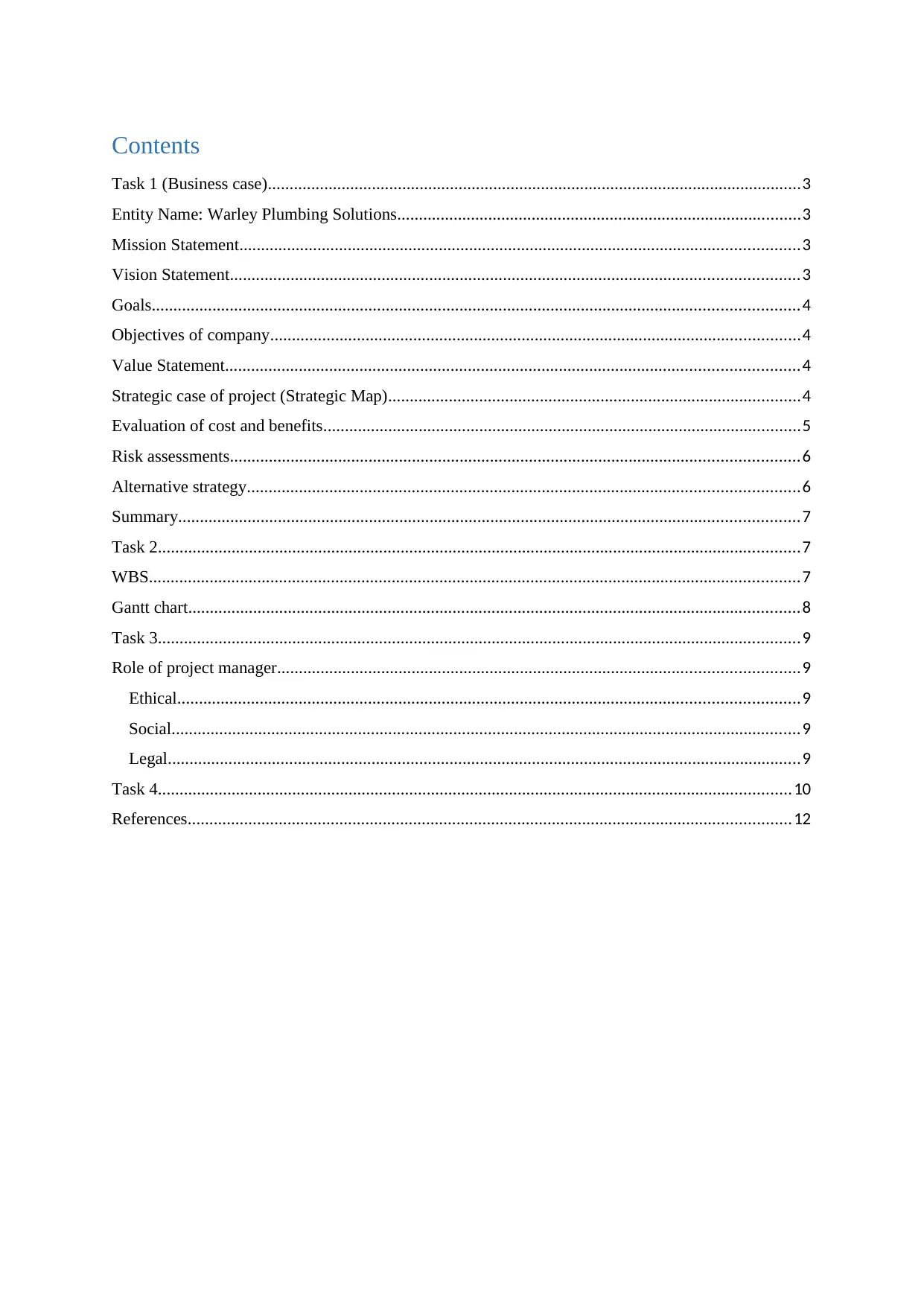
Contents
Task 1 (Business case)...........................................................................................................................3
Entity Name: Warley Plumbing Solutions.............................................................................................3
Mission Statement.................................................................................................................................3
Vision Statement...................................................................................................................................3
Goals.....................................................................................................................................................4
Objectives of company..........................................................................................................................4
Value Statement....................................................................................................................................4
Strategic case of project (Strategic Map)...............................................................................................4
Evaluation of cost and benefits..............................................................................................................5
Risk assessments...................................................................................................................................6
Alternative strategy...............................................................................................................................6
Summary...............................................................................................................................................7
Task 2....................................................................................................................................................7
WBS......................................................................................................................................................7
Gantt chart.............................................................................................................................................8
Task 3....................................................................................................................................................9
Role of project manager........................................................................................................................9
Ethical...............................................................................................................................................9
Social.................................................................................................................................................9
Legal..................................................................................................................................................9
Task 4..................................................................................................................................................10
References...........................................................................................................................................12
Task 1 (Business case)...........................................................................................................................3
Entity Name: Warley Plumbing Solutions.............................................................................................3
Mission Statement.................................................................................................................................3
Vision Statement...................................................................................................................................3
Goals.....................................................................................................................................................4
Objectives of company..........................................................................................................................4
Value Statement....................................................................................................................................4
Strategic case of project (Strategic Map)...............................................................................................4
Evaluation of cost and benefits..............................................................................................................5
Risk assessments...................................................................................................................................6
Alternative strategy...............................................................................................................................6
Summary...............................................................................................................................................7
Task 2....................................................................................................................................................7
WBS......................................................................................................................................................7
Gantt chart.............................................................................................................................................8
Task 3....................................................................................................................................................9
Role of project manager........................................................................................................................9
Ethical...............................................................................................................................................9
Social.................................................................................................................................................9
Legal..................................................................................................................................................9
Task 4..................................................................................................................................................10
References...........................................................................................................................................12
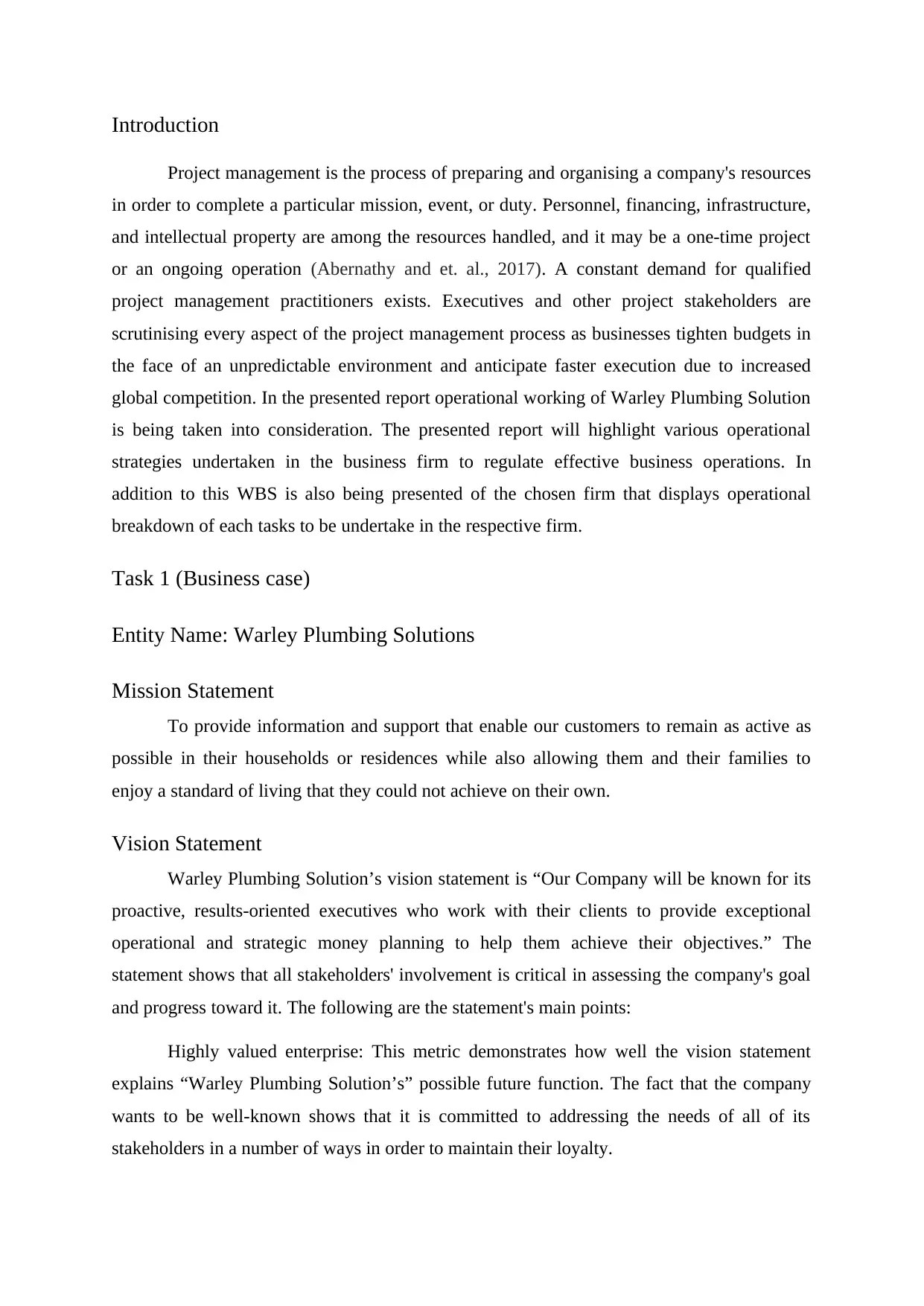
Introduction
Project management is the process of preparing and organising a company's resources
in order to complete a particular mission, event, or duty. Personnel, financing, infrastructure,
and intellectual property are among the resources handled, and it may be a one-time project
or an ongoing operation (Abernathy and et. al., 2017). A constant demand for qualified
project management practitioners exists. Executives and other project stakeholders are
scrutinising every aspect of the project management process as businesses tighten budgets in
the face of an unpredictable environment and anticipate faster execution due to increased
global competition. In the presented report operational working of Warley Plumbing Solution
is being taken into consideration. The presented report will highlight various operational
strategies undertaken in the business firm to regulate effective business operations. In
addition to this WBS is also being presented of the chosen firm that displays operational
breakdown of each tasks to be undertake in the respective firm.
Task 1 (Business case)
Entity Name: Warley Plumbing Solutions
Mission Statement
To provide information and support that enable our customers to remain as active as
possible in their households or residences while also allowing them and their families to
enjoy a standard of living that they could not achieve on their own.
Vision Statement
Warley Plumbing Solution’s vision statement is “Our Company will be known for its
proactive, results-oriented executives who work with their clients to provide exceptional
operational and strategic money planning to help them achieve their objectives.” The
statement shows that all stakeholders' involvement is critical in assessing the company's goal
and progress toward it. The following are the statement's main points:
Highly valued enterprise: This metric demonstrates how well the vision statement
explains “Warley Plumbing Solution’s” possible future function. The fact that the company
wants to be well-known shows that it is committed to addressing the needs of all of its
stakeholders in a number of ways in order to maintain their loyalty.
Project management is the process of preparing and organising a company's resources
in order to complete a particular mission, event, or duty. Personnel, financing, infrastructure,
and intellectual property are among the resources handled, and it may be a one-time project
or an ongoing operation (Abernathy and et. al., 2017). A constant demand for qualified
project management practitioners exists. Executives and other project stakeholders are
scrutinising every aspect of the project management process as businesses tighten budgets in
the face of an unpredictable environment and anticipate faster execution due to increased
global competition. In the presented report operational working of Warley Plumbing Solution
is being taken into consideration. The presented report will highlight various operational
strategies undertaken in the business firm to regulate effective business operations. In
addition to this WBS is also being presented of the chosen firm that displays operational
breakdown of each tasks to be undertake in the respective firm.
Task 1 (Business case)
Entity Name: Warley Plumbing Solutions
Mission Statement
To provide information and support that enable our customers to remain as active as
possible in their households or residences while also allowing them and their families to
enjoy a standard of living that they could not achieve on their own.
Vision Statement
Warley Plumbing Solution’s vision statement is “Our Company will be known for its
proactive, results-oriented executives who work with their clients to provide exceptional
operational and strategic money planning to help them achieve their objectives.” The
statement shows that all stakeholders' involvement is critical in assessing the company's goal
and progress toward it. The following are the statement's main points:
Highly valued enterprise: This metric demonstrates how well the vision statement
explains “Warley Plumbing Solution’s” possible future function. The fact that the company
wants to be well-known shows that it is committed to addressing the needs of all of its
stakeholders in a number of ways in order to maintain their loyalty.
⊘ This is a preview!⊘
Do you want full access?
Subscribe today to unlock all pages.

Trusted by 1+ million students worldwide
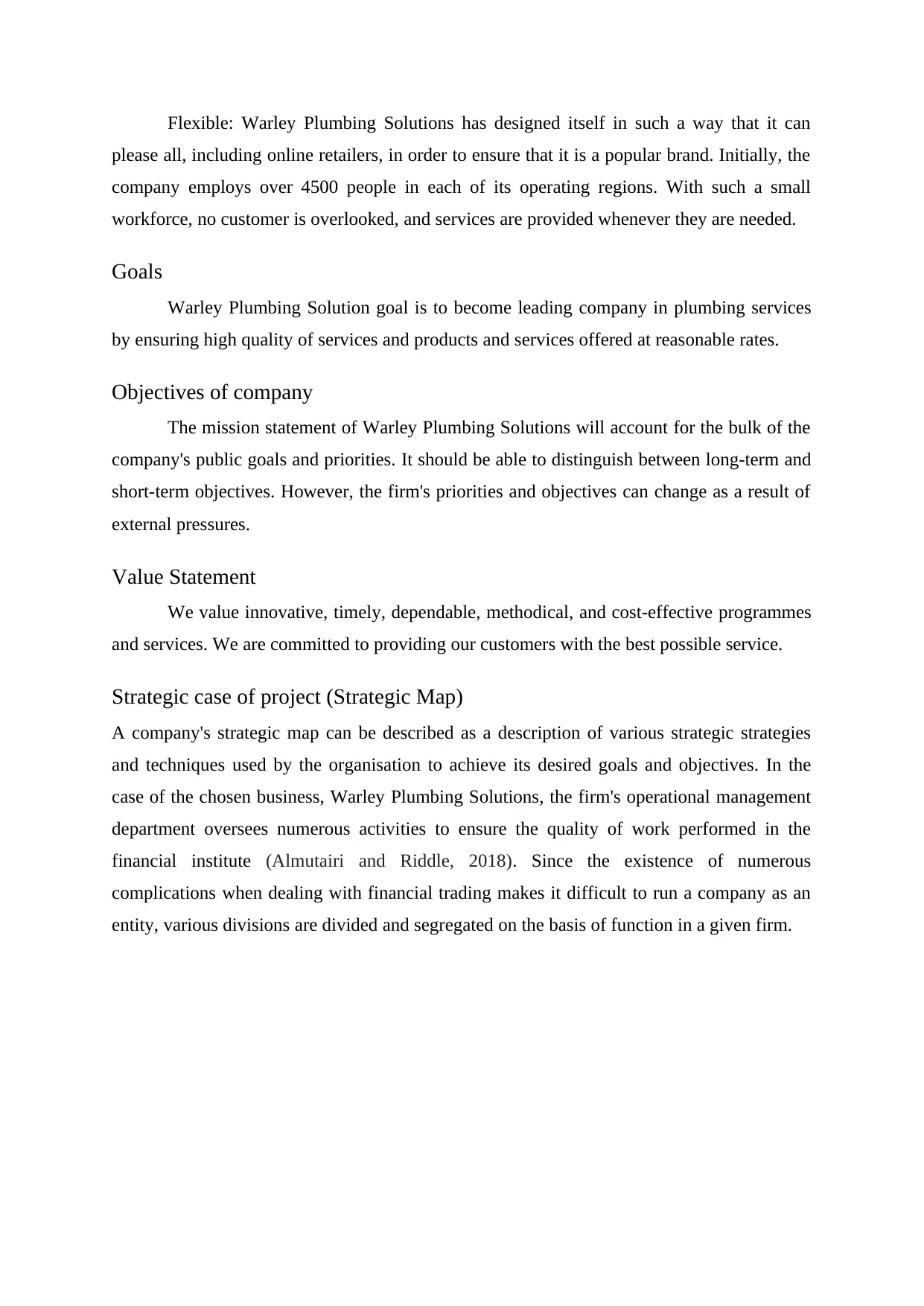
Flexible: Warley Plumbing Solutions has designed itself in such a way that it can
please all, including online retailers, in order to ensure that it is a popular brand. Initially, the
company employs over 4500 people in each of its operating regions. With such a small
workforce, no customer is overlooked, and services are provided whenever they are needed.
Goals
Warley Plumbing Solution goal is to become leading company in plumbing services
by ensuring high quality of services and products and services offered at reasonable rates.
Objectives of company
The mission statement of Warley Plumbing Solutions will account for the bulk of the
company's public goals and priorities. It should be able to distinguish between long-term and
short-term objectives. However, the firm's priorities and objectives can change as a result of
external pressures.
Value Statement
We value innovative, timely, dependable, methodical, and cost-effective programmes
and services. We are committed to providing our customers with the best possible service.
Strategic case of project (Strategic Map)
A company's strategic map can be described as a description of various strategic strategies
and techniques used by the organisation to achieve its desired goals and objectives. In the
case of the chosen business, Warley Plumbing Solutions, the firm's operational management
department oversees numerous activities to ensure the quality of work performed in the
financial institute (Almutairi and Riddle, 2018). Since the existence of numerous
complications when dealing with financial trading makes it difficult to run a company as an
entity, various divisions are divided and segregated on the basis of function in a given firm.
please all, including online retailers, in order to ensure that it is a popular brand. Initially, the
company employs over 4500 people in each of its operating regions. With such a small
workforce, no customer is overlooked, and services are provided whenever they are needed.
Goals
Warley Plumbing Solution goal is to become leading company in plumbing services
by ensuring high quality of services and products and services offered at reasonable rates.
Objectives of company
The mission statement of Warley Plumbing Solutions will account for the bulk of the
company's public goals and priorities. It should be able to distinguish between long-term and
short-term objectives. However, the firm's priorities and objectives can change as a result of
external pressures.
Value Statement
We value innovative, timely, dependable, methodical, and cost-effective programmes
and services. We are committed to providing our customers with the best possible service.
Strategic case of project (Strategic Map)
A company's strategic map can be described as a description of various strategic strategies
and techniques used by the organisation to achieve its desired goals and objectives. In the
case of the chosen business, Warley Plumbing Solutions, the firm's operational management
department oversees numerous activities to ensure the quality of work performed in the
financial institute (Almutairi and Riddle, 2018). Since the existence of numerous
complications when dealing with financial trading makes it difficult to run a company as an
entity, various divisions are divided and segregated on the basis of function in a given firm.
Paraphrase This Document
Need a fresh take? Get an instant paraphrase of this document with our AI Paraphraser
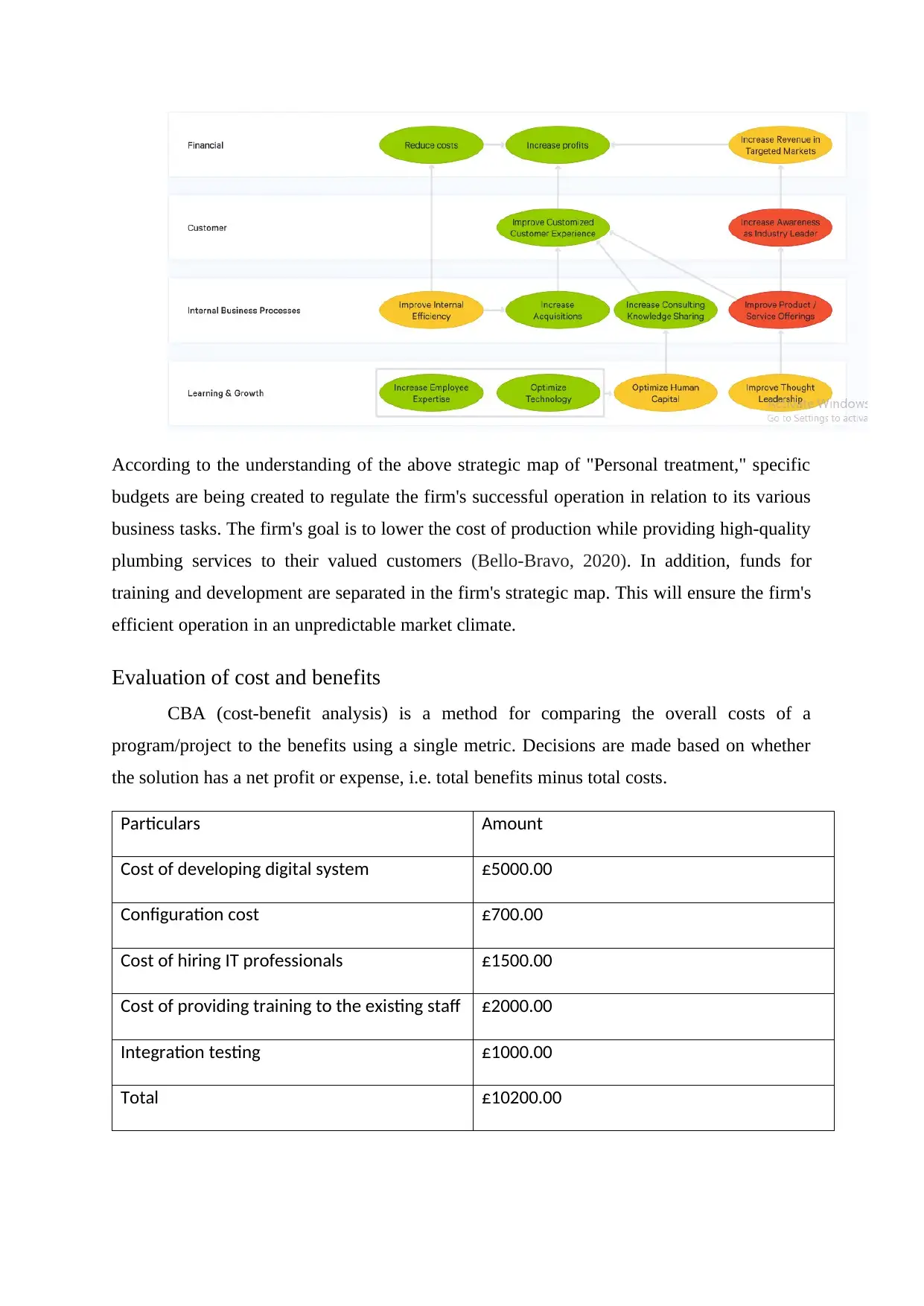
According to the understanding of the above strategic map of "Personal treatment," specific
budgets are being created to regulate the firm's successful operation in relation to its various
business tasks. The firm's goal is to lower the cost of production while providing high-quality
plumbing services to their valued customers (Bello-Bravo, 2020). In addition, funds for
training and development are separated in the firm's strategic map. This will ensure the firm's
efficient operation in an unpredictable market climate.
Evaluation of cost and benefits
CBA (cost-benefit analysis) is a method for comparing the overall costs of a
program/project to the benefits using a single metric. Decisions are made based on whether
the solution has a net profit or expense, i.e. total benefits minus total costs.
Particulars Amount
Cost of developing digital system £5000.00
Configuration cost £700.00
Cost of hiring IT professionals £1500.00
Cost of providing training to the existing staff £2000.00
Integration testing £1000.00
Total £10200.00
budgets are being created to regulate the firm's successful operation in relation to its various
business tasks. The firm's goal is to lower the cost of production while providing high-quality
plumbing services to their valued customers (Bello-Bravo, 2020). In addition, funds for
training and development are separated in the firm's strategic map. This will ensure the firm's
efficient operation in an unpredictable market climate.
Evaluation of cost and benefits
CBA (cost-benefit analysis) is a method for comparing the overall costs of a
program/project to the benefits using a single metric. Decisions are made based on whether
the solution has a net profit or expense, i.e. total benefits minus total costs.
Particulars Amount
Cost of developing digital system £5000.00
Configuration cost £700.00
Cost of hiring IT professionals £1500.00
Cost of providing training to the existing staff £2000.00
Integration testing £1000.00
Total £10200.00
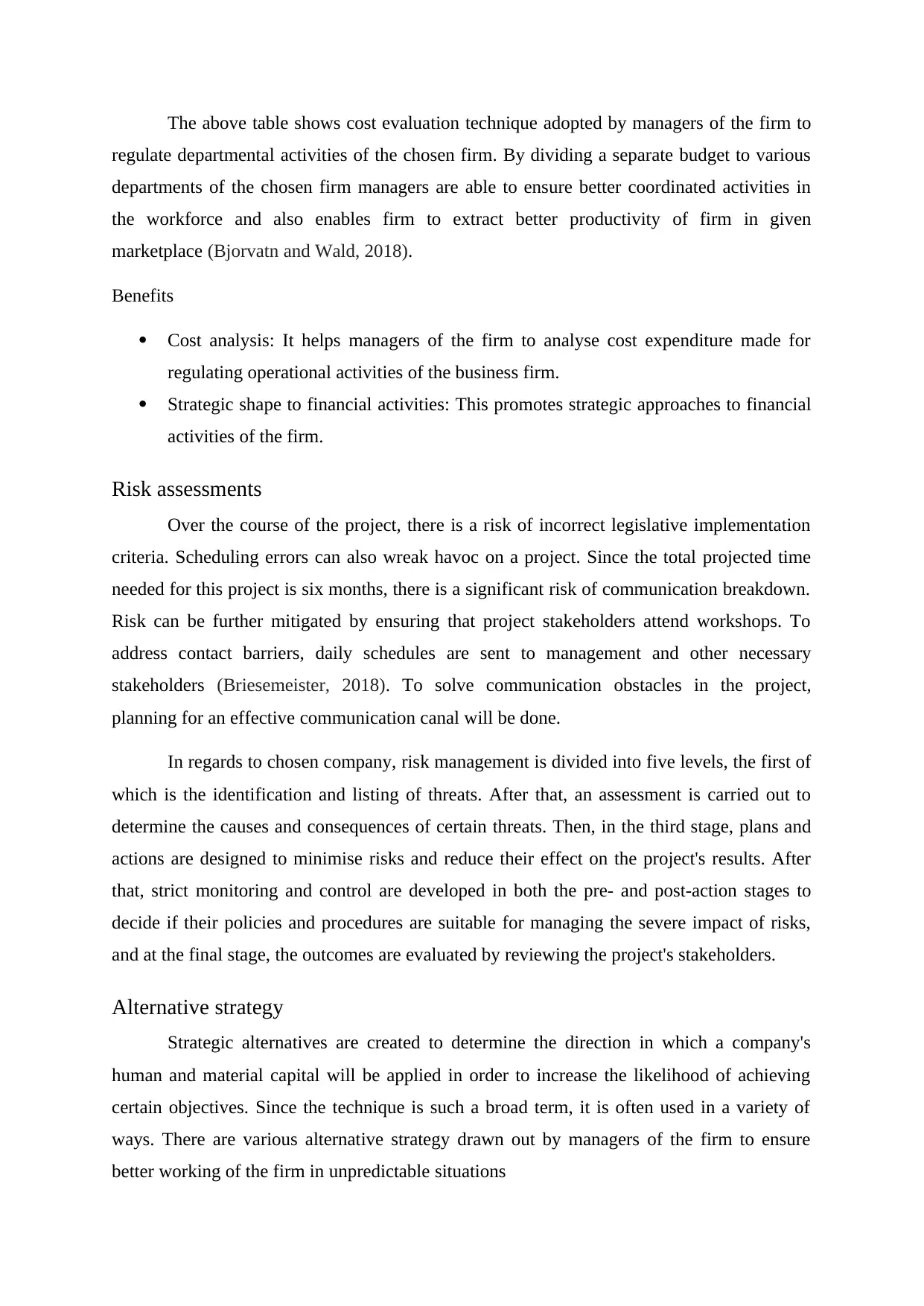
The above table shows cost evaluation technique adopted by managers of the firm to
regulate departmental activities of the chosen firm. By dividing a separate budget to various
departments of the chosen firm managers are able to ensure better coordinated activities in
the workforce and also enables firm to extract better productivity of firm in given
marketplace (Bjorvatn and Wald, 2018).
Benefits
Cost analysis: It helps managers of the firm to analyse cost expenditure made for
regulating operational activities of the business firm.
Strategic shape to financial activities: This promotes strategic approaches to financial
activities of the firm.
Risk assessments
Over the course of the project, there is a risk of incorrect legislative implementation
criteria. Scheduling errors can also wreak havoc on a project. Since the total projected time
needed for this project is six months, there is a significant risk of communication breakdown.
Risk can be further mitigated by ensuring that project stakeholders attend workshops. To
address contact barriers, daily schedules are sent to management and other necessary
stakeholders (Briesemeister, 2018). To solve communication obstacles in the project,
planning for an effective communication canal will be done.
In regards to chosen company, risk management is divided into five levels, the first of
which is the identification and listing of threats. After that, an assessment is carried out to
determine the causes and consequences of certain threats. Then, in the third stage, plans and
actions are designed to minimise risks and reduce their effect on the project's results. After
that, strict monitoring and control are developed in both the pre- and post-action stages to
decide if their policies and procedures are suitable for managing the severe impact of risks,
and at the final stage, the outcomes are evaluated by reviewing the project's stakeholders.
Alternative strategy
Strategic alternatives are created to determine the direction in which a company's
human and material capital will be applied in order to increase the likelihood of achieving
certain objectives. Since the technique is such a broad term, it is often used in a variety of
ways. There are various alternative strategy drawn out by managers of the firm to ensure
better working of the firm in unpredictable situations
regulate departmental activities of the chosen firm. By dividing a separate budget to various
departments of the chosen firm managers are able to ensure better coordinated activities in
the workforce and also enables firm to extract better productivity of firm in given
marketplace (Bjorvatn and Wald, 2018).
Benefits
Cost analysis: It helps managers of the firm to analyse cost expenditure made for
regulating operational activities of the business firm.
Strategic shape to financial activities: This promotes strategic approaches to financial
activities of the firm.
Risk assessments
Over the course of the project, there is a risk of incorrect legislative implementation
criteria. Scheduling errors can also wreak havoc on a project. Since the total projected time
needed for this project is six months, there is a significant risk of communication breakdown.
Risk can be further mitigated by ensuring that project stakeholders attend workshops. To
address contact barriers, daily schedules are sent to management and other necessary
stakeholders (Briesemeister, 2018). To solve communication obstacles in the project,
planning for an effective communication canal will be done.
In regards to chosen company, risk management is divided into five levels, the first of
which is the identification and listing of threats. After that, an assessment is carried out to
determine the causes and consequences of certain threats. Then, in the third stage, plans and
actions are designed to minimise risks and reduce their effect on the project's results. After
that, strict monitoring and control are developed in both the pre- and post-action stages to
decide if their policies and procedures are suitable for managing the severe impact of risks,
and at the final stage, the outcomes are evaluated by reviewing the project's stakeholders.
Alternative strategy
Strategic alternatives are created to determine the direction in which a company's
human and material capital will be applied in order to increase the likelihood of achieving
certain objectives. Since the technique is such a broad term, it is often used in a variety of
ways. There are various alternative strategy drawn out by managers of the firm to ensure
better working of the firm in unpredictable situations
⊘ This is a preview!⊘
Do you want full access?
Subscribe today to unlock all pages.

Trusted by 1+ million students worldwide
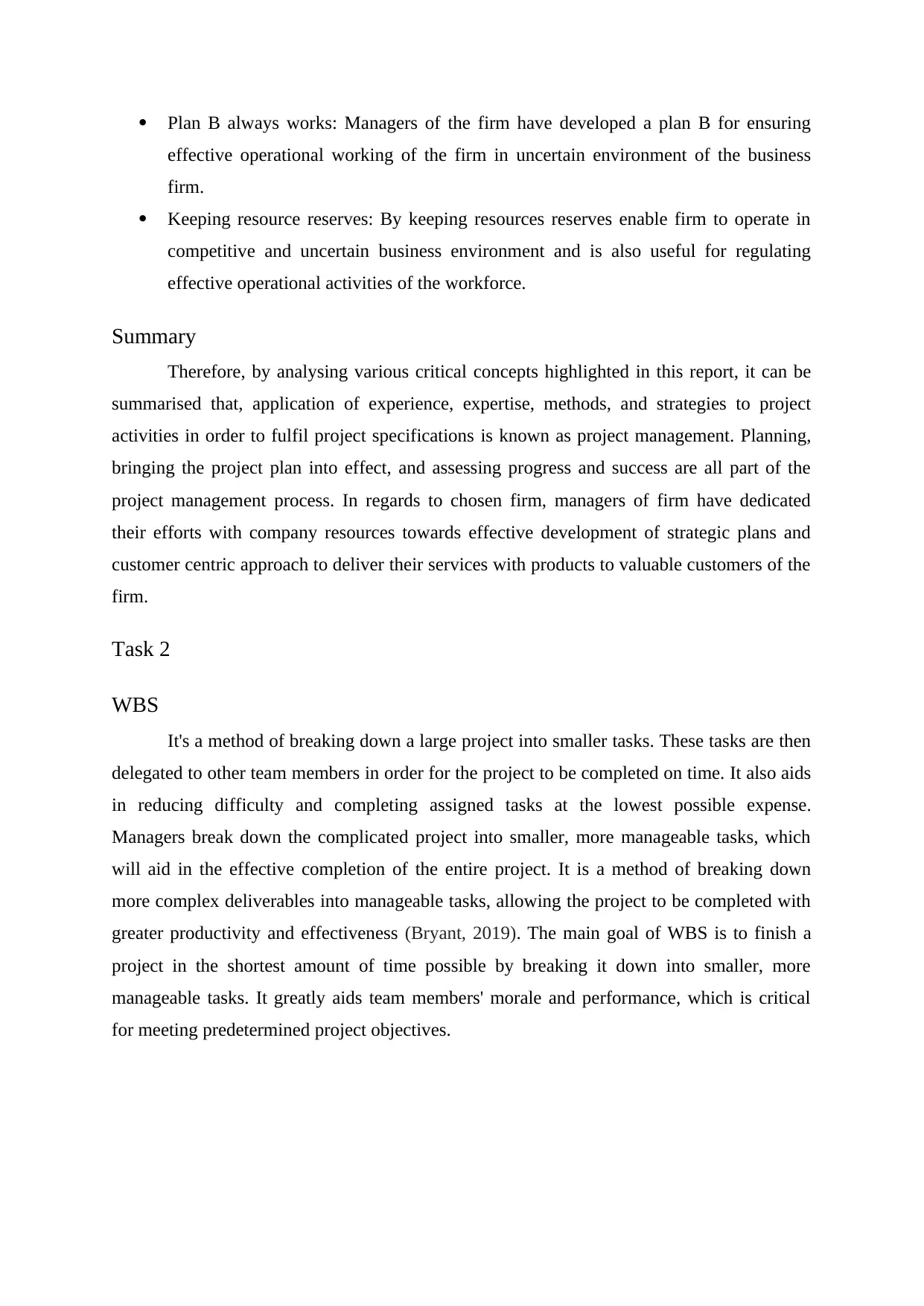
Plan B always works: Managers of the firm have developed a plan B for ensuring
effective operational working of the firm in uncertain environment of the business
firm.
Keeping resource reserves: By keeping resources reserves enable firm to operate in
competitive and uncertain business environment and is also useful for regulating
effective operational activities of the workforce.
Summary
Therefore, by analysing various critical concepts highlighted in this report, it can be
summarised that, application of experience, expertise, methods, and strategies to project
activities in order to fulfil project specifications is known as project management. Planning,
bringing the project plan into effect, and assessing progress and success are all part of the
project management process. In regards to chosen firm, managers of firm have dedicated
their efforts with company resources towards effective development of strategic plans and
customer centric approach to deliver their services with products to valuable customers of the
firm.
Task 2
WBS
It's a method of breaking down a large project into smaller tasks. These tasks are then
delegated to other team members in order for the project to be completed on time. It also aids
in reducing difficulty and completing assigned tasks at the lowest possible expense.
Managers break down the complicated project into smaller, more manageable tasks, which
will aid in the effective completion of the entire project. It is a method of breaking down
more complex deliverables into manageable tasks, allowing the project to be completed with
greater productivity and effectiveness (Bryant, 2019). The main goal of WBS is to finish a
project in the shortest amount of time possible by breaking it down into smaller, more
manageable tasks. It greatly aids team members' morale and performance, which is critical
for meeting predetermined project objectives.
effective operational working of the firm in uncertain environment of the business
firm.
Keeping resource reserves: By keeping resources reserves enable firm to operate in
competitive and uncertain business environment and is also useful for regulating
effective operational activities of the workforce.
Summary
Therefore, by analysing various critical concepts highlighted in this report, it can be
summarised that, application of experience, expertise, methods, and strategies to project
activities in order to fulfil project specifications is known as project management. Planning,
bringing the project plan into effect, and assessing progress and success are all part of the
project management process. In regards to chosen firm, managers of firm have dedicated
their efforts with company resources towards effective development of strategic plans and
customer centric approach to deliver their services with products to valuable customers of the
firm.
Task 2
WBS
It's a method of breaking down a large project into smaller tasks. These tasks are then
delegated to other team members in order for the project to be completed on time. It also aids
in reducing difficulty and completing assigned tasks at the lowest possible expense.
Managers break down the complicated project into smaller, more manageable tasks, which
will aid in the effective completion of the entire project. It is a method of breaking down
more complex deliverables into manageable tasks, allowing the project to be completed with
greater productivity and effectiveness (Bryant, 2019). The main goal of WBS is to finish a
project in the shortest amount of time possible by breaking it down into smaller, more
manageable tasks. It greatly aids team members' morale and performance, which is critical
for meeting predetermined project objectives.
Paraphrase This Document
Need a fresh take? Get an instant paraphrase of this document with our AI Paraphraser
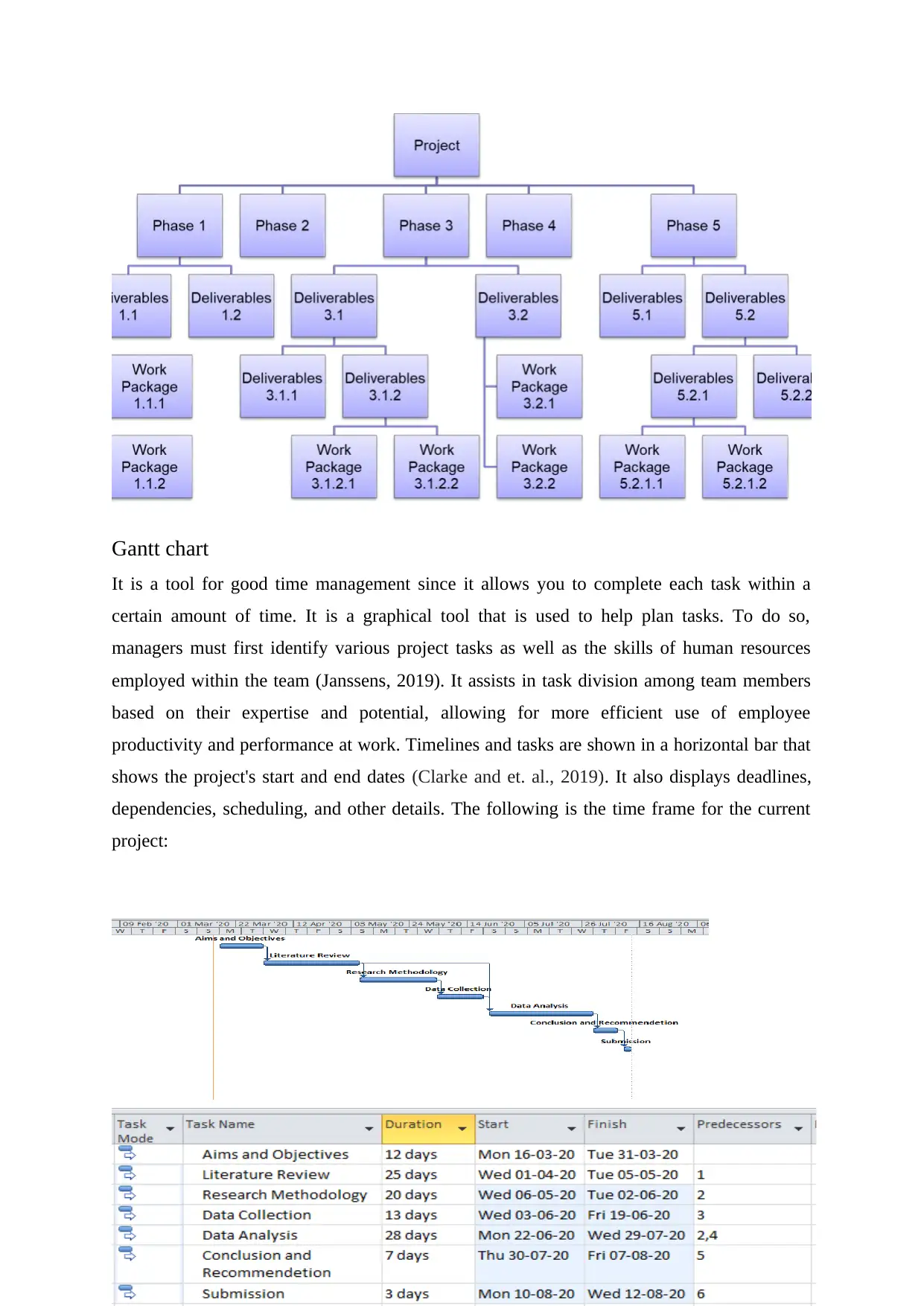
Gantt chart
It is a tool for good time management since it allows you to complete each task within a
certain amount of time. It is a graphical tool that is used to help plan tasks. To do so,
managers must first identify various project tasks as well as the skills of human resources
employed within the team (Janssens, 2019). It assists in task division among team members
based on their expertise and potential, allowing for more efficient use of employee
productivity and performance at work. Timelines and tasks are shown in a horizontal bar that
shows the project's start and end dates (Clarke and et. al., 2019). It also displays deadlines,
dependencies, scheduling, and other details. The following is the time frame for the current
project:
It is a tool for good time management since it allows you to complete each task within a
certain amount of time. It is a graphical tool that is used to help plan tasks. To do so,
managers must first identify various project tasks as well as the skills of human resources
employed within the team (Janssens, 2019). It assists in task division among team members
based on their expertise and potential, allowing for more efficient use of employee
productivity and performance at work. Timelines and tasks are shown in a horizontal bar that
shows the project's start and end dates (Clarke and et. al., 2019). It also displays deadlines,
dependencies, scheduling, and other details. The following is the time frame for the current
project:
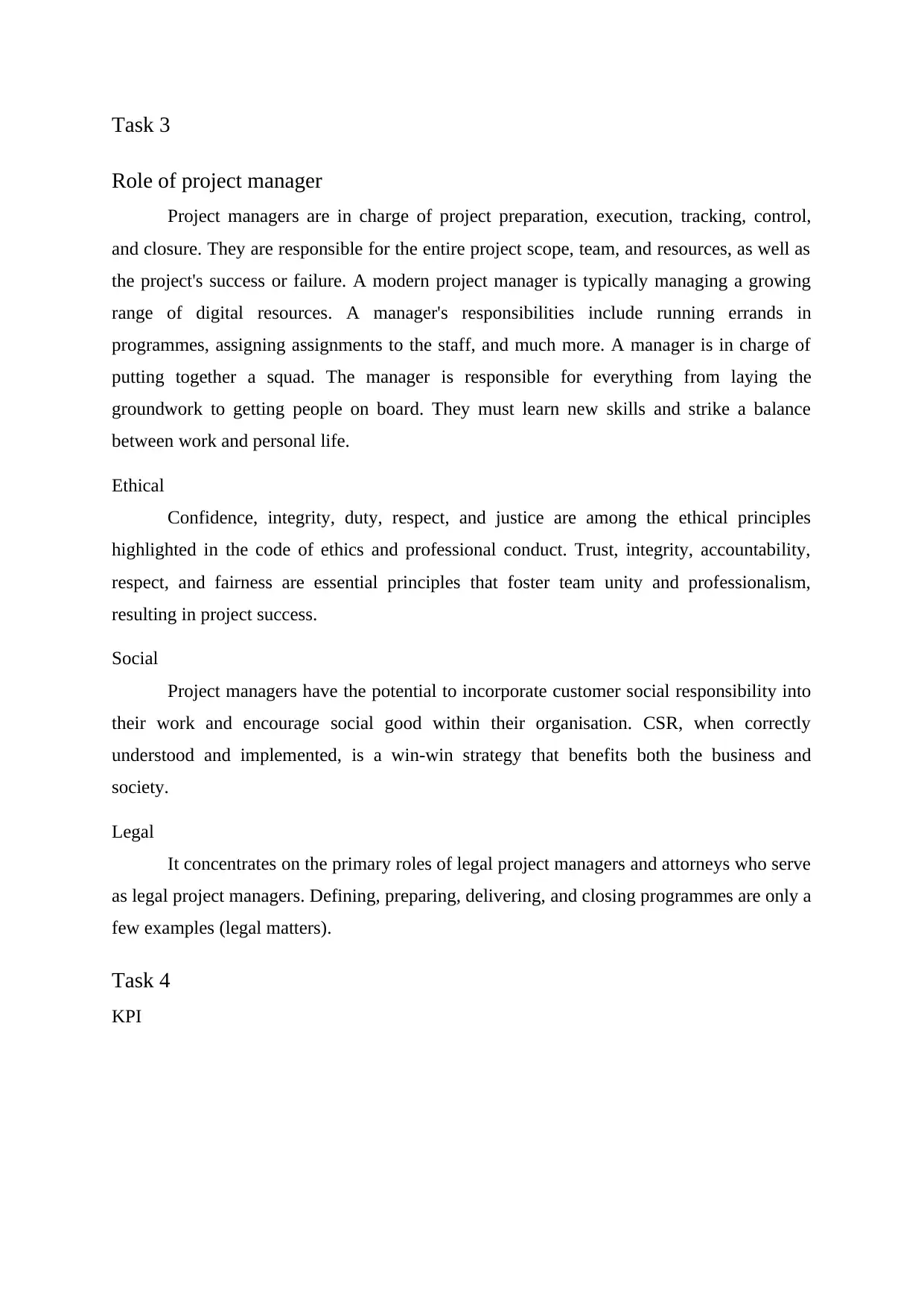
Task 3
Role of project manager
Project managers are in charge of project preparation, execution, tracking, control,
and closure. They are responsible for the entire project scope, team, and resources, as well as
the project's success or failure. A modern project manager is typically managing a growing
range of digital resources. A manager's responsibilities include running errands in
programmes, assigning assignments to the staff, and much more. A manager is in charge of
putting together a squad. The manager is responsible for everything from laying the
groundwork to getting people on board. They must learn new skills and strike a balance
between work and personal life.
Ethical
Confidence, integrity, duty, respect, and justice are among the ethical principles
highlighted in the code of ethics and professional conduct. Trust, integrity, accountability,
respect, and fairness are essential principles that foster team unity and professionalism,
resulting in project success.
Social
Project managers have the potential to incorporate customer social responsibility into
their work and encourage social good within their organisation. CSR, when correctly
understood and implemented, is a win-win strategy that benefits both the business and
society.
Legal
It concentrates on the primary roles of legal project managers and attorneys who serve
as legal project managers. Defining, preparing, delivering, and closing programmes are only a
few examples (legal matters).
Task 4
KPI
Role of project manager
Project managers are in charge of project preparation, execution, tracking, control,
and closure. They are responsible for the entire project scope, team, and resources, as well as
the project's success or failure. A modern project manager is typically managing a growing
range of digital resources. A manager's responsibilities include running errands in
programmes, assigning assignments to the staff, and much more. A manager is in charge of
putting together a squad. The manager is responsible for everything from laying the
groundwork to getting people on board. They must learn new skills and strike a balance
between work and personal life.
Ethical
Confidence, integrity, duty, respect, and justice are among the ethical principles
highlighted in the code of ethics and professional conduct. Trust, integrity, accountability,
respect, and fairness are essential principles that foster team unity and professionalism,
resulting in project success.
Social
Project managers have the potential to incorporate customer social responsibility into
their work and encourage social good within their organisation. CSR, when correctly
understood and implemented, is a win-win strategy that benefits both the business and
society.
Legal
It concentrates on the primary roles of legal project managers and attorneys who serve
as legal project managers. Defining, preparing, delivering, and closing programmes are only a
few examples (legal matters).
Task 4
KPI
⊘ This is a preview!⊘
Do you want full access?
Subscribe today to unlock all pages.

Trusted by 1+ million students worldwide
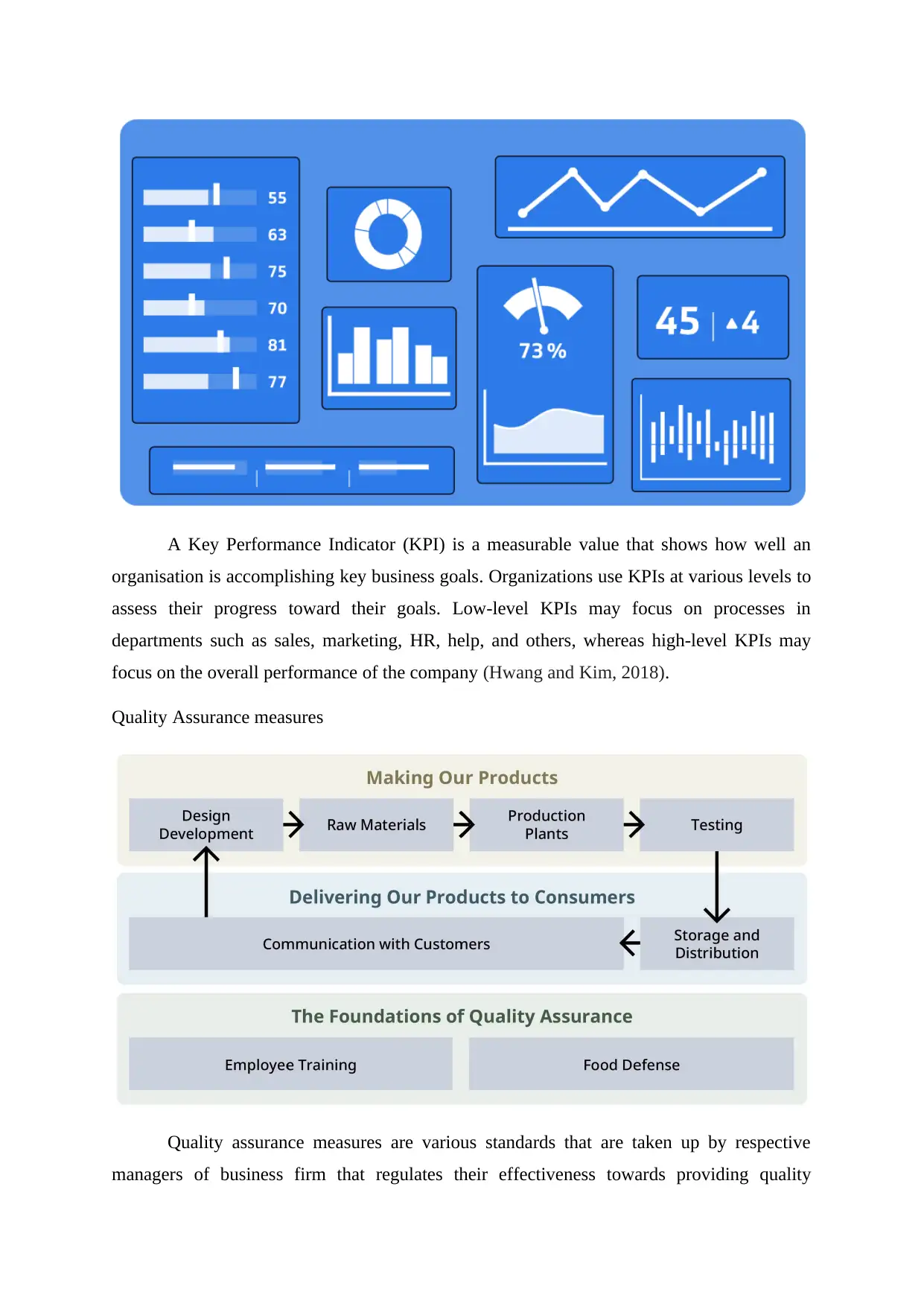
A Key Performance Indicator (KPI) is a measurable value that shows how well an
organisation is accomplishing key business goals. Organizations use KPIs at various levels to
assess their progress toward their goals. Low-level KPIs may focus on processes in
departments such as sales, marketing, HR, help, and others, whereas high-level KPIs may
focus on the overall performance of the company (Hwang and Kim, 2018).
Quality Assurance measures
Quality assurance measures are various standards that are taken up by respective
managers of business firm that regulates their effectiveness towards providing quality
organisation is accomplishing key business goals. Organizations use KPIs at various levels to
assess their progress toward their goals. Low-level KPIs may focus on processes in
departments such as sales, marketing, HR, help, and others, whereas high-level KPIs may
focus on the overall performance of the company (Hwang and Kim, 2018).
Quality Assurance measures
Quality assurance measures are various standards that are taken up by respective
managers of business firm that regulates their effectiveness towards providing quality
Paraphrase This Document
Need a fresh take? Get an instant paraphrase of this document with our AI Paraphraser
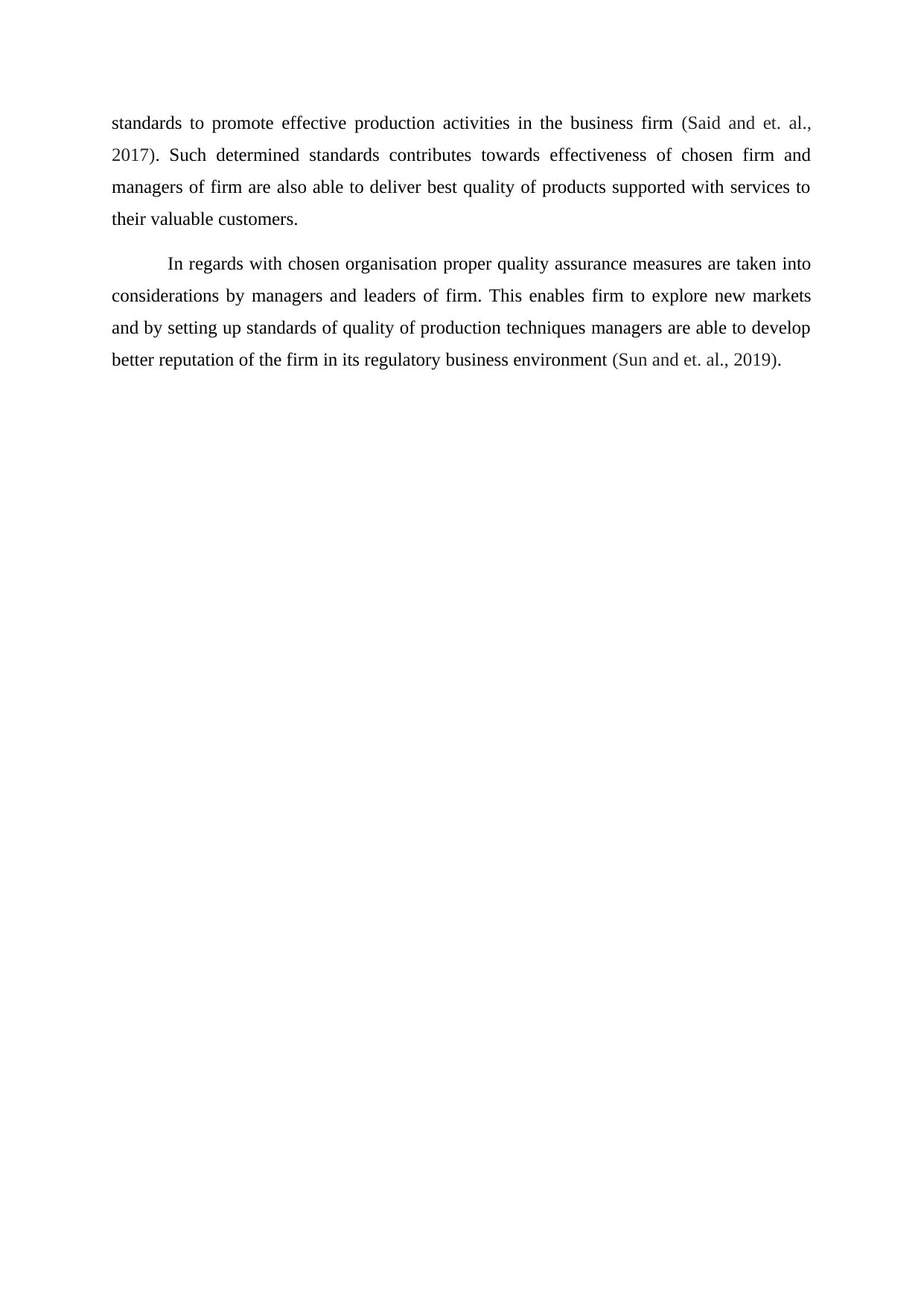
standards to promote effective production activities in the business firm (Said and et. al.,
2017). Such determined standards contributes towards effectiveness of chosen firm and
managers of firm are also able to deliver best quality of products supported with services to
their valuable customers.
In regards with chosen organisation proper quality assurance measures are taken into
considerations by managers and leaders of firm. This enables firm to explore new markets
and by setting up standards of quality of production techniques managers are able to develop
better reputation of the firm in its regulatory business environment (Sun and et. al., 2019).
2017). Such determined standards contributes towards effectiveness of chosen firm and
managers of firm are also able to deliver best quality of products supported with services to
their valuable customers.
In regards with chosen organisation proper quality assurance measures are taken into
considerations by managers and leaders of firm. This enables firm to explore new markets
and by setting up standards of quality of production techniques managers are able to develop
better reputation of the firm in its regulatory business environment (Sun and et. al., 2019).
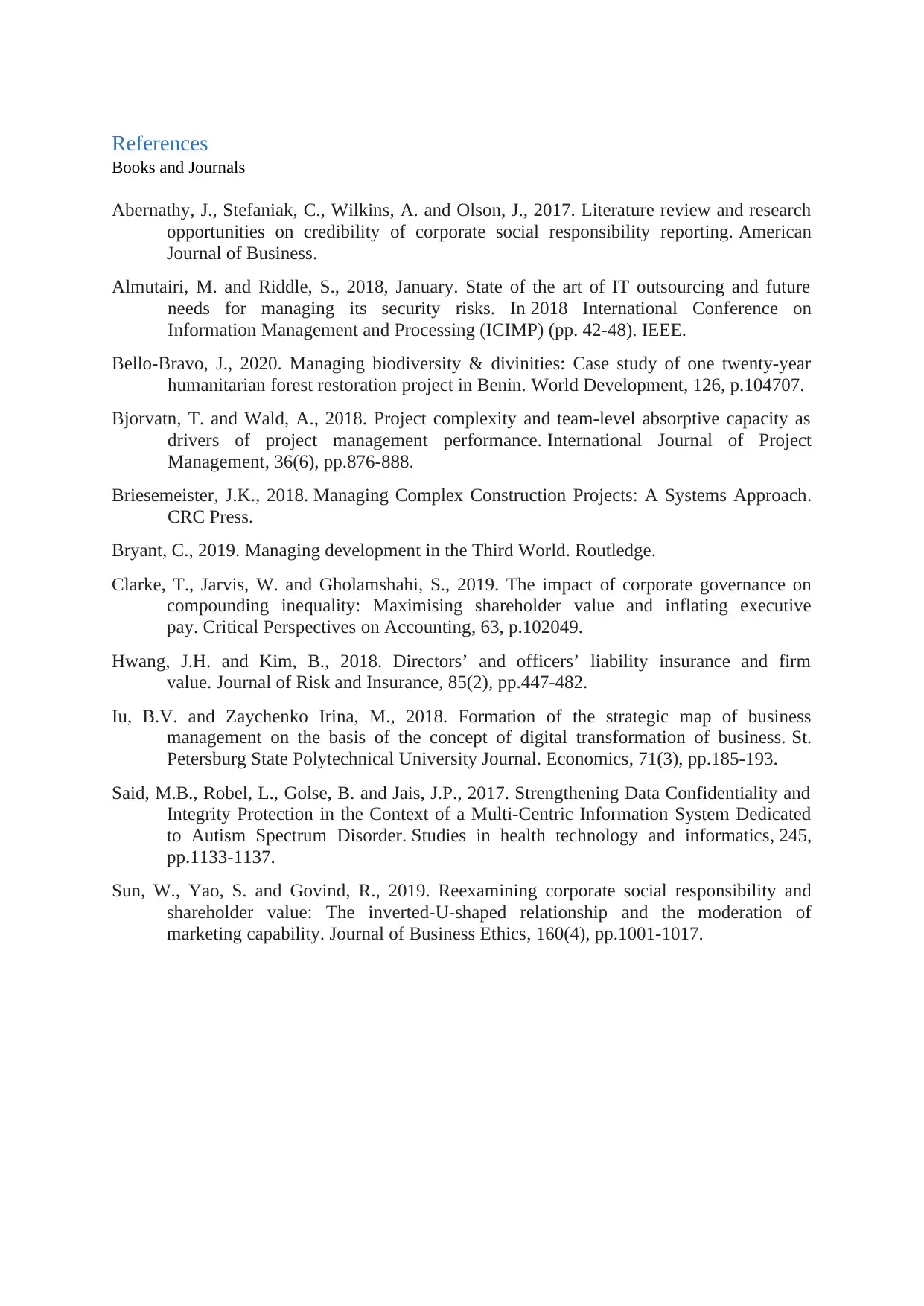
References
Books and Journals
Abernathy, J., Stefaniak, C., Wilkins, A. and Olson, J., 2017. Literature review and research
opportunities on credibility of corporate social responsibility reporting. American
Journal of Business.
Almutairi, M. and Riddle, S., 2018, January. State of the art of IT outsourcing and future
needs for managing its security risks. In 2018 International Conference on
Information Management and Processing (ICIMP) (pp. 42-48). IEEE.
Bello-Bravo, J., 2020. Managing biodiversity & divinities: Case study of one twenty-year
humanitarian forest restoration project in Benin. World Development, 126, p.104707.
Bjorvatn, T. and Wald, A., 2018. Project complexity and team-level absorptive capacity as
drivers of project management performance. International Journal of Project
Management, 36(6), pp.876-888.
Briesemeister, J.K., 2018. Managing Complex Construction Projects: A Systems Approach.
CRC Press.
Bryant, C., 2019. Managing development in the Third World. Routledge.
Clarke, T., Jarvis, W. and Gholamshahi, S., 2019. The impact of corporate governance on
compounding inequality: Maximising shareholder value and inflating executive
pay. Critical Perspectives on Accounting, 63, p.102049.
Hwang, J.H. and Kim, B., 2018. Directors’ and officers’ liability insurance and firm
value. Journal of Risk and Insurance, 85(2), pp.447-482.
Iu, B.V. and Zaychenko Irina, M., 2018. Formation of the strategic map of business
management on the basis of the concept of digital transformation of business. St.
Petersburg State Polytechnical University Journal. Economics, 71(3), pp.185-193.
Said, M.B., Robel, L., Golse, B. and Jais, J.P., 2017. Strengthening Data Confidentiality and
Integrity Protection in the Context of a Multi-Centric Information System Dedicated
to Autism Spectrum Disorder. Studies in health technology and informatics, 245,
pp.1133-1137.
Sun, W., Yao, S. and Govind, R., 2019. Reexamining corporate social responsibility and
shareholder value: The inverted-U-shaped relationship and the moderation of
marketing capability. Journal of Business Ethics, 160(4), pp.1001-1017.
Books and Journals
Abernathy, J., Stefaniak, C., Wilkins, A. and Olson, J., 2017. Literature review and research
opportunities on credibility of corporate social responsibility reporting. American
Journal of Business.
Almutairi, M. and Riddle, S., 2018, January. State of the art of IT outsourcing and future
needs for managing its security risks. In 2018 International Conference on
Information Management and Processing (ICIMP) (pp. 42-48). IEEE.
Bello-Bravo, J., 2020. Managing biodiversity & divinities: Case study of one twenty-year
humanitarian forest restoration project in Benin. World Development, 126, p.104707.
Bjorvatn, T. and Wald, A., 2018. Project complexity and team-level absorptive capacity as
drivers of project management performance. International Journal of Project
Management, 36(6), pp.876-888.
Briesemeister, J.K., 2018. Managing Complex Construction Projects: A Systems Approach.
CRC Press.
Bryant, C., 2019. Managing development in the Third World. Routledge.
Clarke, T., Jarvis, W. and Gholamshahi, S., 2019. The impact of corporate governance on
compounding inequality: Maximising shareholder value and inflating executive
pay. Critical Perspectives on Accounting, 63, p.102049.
Hwang, J.H. and Kim, B., 2018. Directors’ and officers’ liability insurance and firm
value. Journal of Risk and Insurance, 85(2), pp.447-482.
Iu, B.V. and Zaychenko Irina, M., 2018. Formation of the strategic map of business
management on the basis of the concept of digital transformation of business. St.
Petersburg State Polytechnical University Journal. Economics, 71(3), pp.185-193.
Said, M.B., Robel, L., Golse, B. and Jais, J.P., 2017. Strengthening Data Confidentiality and
Integrity Protection in the Context of a Multi-Centric Information System Dedicated
to Autism Spectrum Disorder. Studies in health technology and informatics, 245,
pp.1133-1137.
Sun, W., Yao, S. and Govind, R., 2019. Reexamining corporate social responsibility and
shareholder value: The inverted-U-shaped relationship and the moderation of
marketing capability. Journal of Business Ethics, 160(4), pp.1001-1017.
⊘ This is a preview!⊘
Do you want full access?
Subscribe today to unlock all pages.

Trusted by 1+ million students worldwide
1 out of 12
Related Documents
Your All-in-One AI-Powered Toolkit for Academic Success.
+13062052269
info@desklib.com
Available 24*7 on WhatsApp / Email
![[object Object]](/_next/static/media/star-bottom.7253800d.svg)
Unlock your academic potential
Copyright © 2020–2025 A2Z Services. All Rights Reserved. Developed and managed by ZUCOL.





